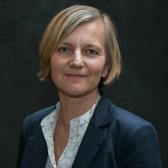
“Between Resistance and Compliance: The Ambivalent Bequest of the Theresienstadt ‘Ghetto’ Films.”
Professional Background
Dr. Natascha Drubek is Heisenberg Fellow in Film Studies, University of Regensburg (Germany). She earned her PhD in Slavic Studies & History of Eastern Europe from Ludwig-Maximilians Universitaet (Germany) in 1998, where she also received her habilitation degree in 2007.
Dr. Drubek speaks Czech , German, and Russian. She is co-editor of the series Osteuropa Medial at Boehlau and has been the editor of the film section of Artmargins.com since 2003. Dr. Drubek- co-authored Hyperkino, a method of annotation for films. Recent lectures include: “Religion, Race and Rhetorics in Film Propaganda in East and Central Europe 1918-45“ at the NECS Conference in Prage, "Terezín / Theresienstadt 1942-45: Unfreiwilliger Schnittpunkt von Sprachen und Kulturen”, at the Univesity of Łódź in Poland, and “Two Concentration Camps on Film: Representations of Majdanek and Theresienstadt at the End of the War“ in Cambridge, United Kingdom.
Dr. Drubek has published a number of books and scholarly articles. Her books include Russian Light: From the Icon to Early Soviet Cinema (Cologne, Germany: Boehlau, 2012), and The Time-Image of Eastern European Film (Cologne: 2010). Articles she has published include “The Exploited Recordings: Czech and German Voices in the Film ‘Theresienstadt: Ein Dokumentarfilm aus dem jüdischen Siedlungsgebiet’" (194445) in D. Zachar’in’s Electrified Voices: Medial, Socio-Historical and Cultural Aspects of Voice Transfer (Göttingen, Germany: 2012) and “Russian Film Premieres on Religious and National Holidays: Two Case Studies (Pop/The Priest and Predstoianie)” in L. Berezhnaya and Chr. Schmitt’s Iconic Turns: Nation and Religion in Eastern European Cinema since 1989 (Leiden, the Netherlands: 2013). In 1999, Dr. Drubek co-edited one of the first German volumes focusing on Jewish Slavic relations, Juden und Judentum in Literatur und Film des slavischen Sprachraums: Die geniale Epoche (Wiesbaden). She is also planning an international conference in Spetbember, 2014 on the films made in ghettos, which will take place in Terezín.
Fellowship Research
While in residence in the Jack, Joseph and Morton Mandel Center for Advanced Holocaust Studies Dr. Drubek worked on her project entitled “Between Resistance and Compliance: The Ambivalent Bequest of the Theresienstadt ‘Ghetto’ Films.” For her Diane and Howard Wohl Fellowship, Dr. Drubek analyzed two films made in the last surviving Nazi ghetto, Theresienstadt. Before and during the Second World War, the Nazis would use film footage of the inhuman conditions of the ghettos they created as antisemitic propaganda, asserting that this was how all Jews lived. Although aborted, Theresienstadt was viewed as the most “Western” of all the ghettos and the SS wished to portray it as such. The second film was made in 1945 as Germany’s defeat became ever more apparent. As such, it gave a false image of ghettos in general as much more humane, likely in an attempt to avoid harsh punishment at the hands of the Allies.
Dr. Drubek was in-residence at the Mandel Center from December 1, 2013 to March 31, 2014.
